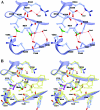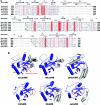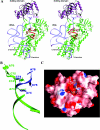Crystal structures of the editing domain of Escherichia coli leucyl-tRNA synthetase and its complexes with Met and Ile reveal a lock-and-key mechanism for amino acid discrimination
- PMID: 16277600
- PMCID: PMC1408670
- DOI: 10.1042/BJ20051249
Crystal structures of the editing domain of Escherichia coli leucyl-tRNA synthetase and its complexes with Met and Ile reveal a lock-and-key mechanism for amino acid discrimination
Abstract
aaRSs (aminoacyl-tRNA synthetases) are responsible for the covalent linking of amino acids to their cognate tRNAs via the aminoacylation reaction and play a vital role in maintaining the fidelity of protein synthesis. LeuRS (leucyl-tRNA synthetase) can link not only the cognate leucine but also the nearly cognate residues Ile and Met to tRNA(Leu). The editing domain of LeuRS deacylates the mischarged Ile-tRNA(Leu) and Met-tRNA(Leu). We report here the crystal structures of ecLeuRS-ED (the editing domain of Escherichia coli LeuRS) in both the apo form and in complexes with Met and Ile at 2.0 A, 2.4 A, and 3.2 A resolution respectively. The editing active site consists of a number of conserved amino acids, which are involved in the precise recognition and binding of the noncognate amino acids. The substrate-binding pocket has a rigid structure which has an optimal stereochemical fit for Ile and Met, but has steric hindrance for leucine. Based on our structural results and previously available biochemical data, we propose that ecLeuRS-ED uses a lock-and-key mechanism to recognize and discriminate between the amino acids. Structural comparison also reveals that all subclass Ia aaRSs share a conserved structure core consisting of the editing domain and conserved residues at the editing active site, suggesting that these enzymes may use a common mechanism for the editing function.
Figures




Similar articles
-
Molecular modeling study of the editing active site of Escherichia coli leucyl-tRNA synthetase: two amino acid binding sites in the editing domain.Proteins. 2004 Mar 1;54(4):693-704. doi: 10.1002/prot.10300. Proteins. 2004. PMID: 14997565
-
Attenuation of the editing activity of the Escherichia coli leucyl-tRNA synthetase allows incorporation of novel amino acids into proteins in vivo.Biochemistry. 2002 Aug 27;41(34):10635-45. doi: 10.1021/bi026130x. Biochemistry. 2002. PMID: 12186549
-
Discrimination of tRNA(Leu) isoacceptors by the mutants of Escherichia coli leucyl-tRNA synthetase in editing.Biochemistry. 2002 Aug 27;41(34):10623-8. doi: 10.1021/bi026000o. Biochemistry. 2002. PMID: 12186547
-
Energy cost of translational proofreading in vivo. The aminoacylation of transfer RNA in Escherichia coli.Ann N Y Acad Sci. 1994 Nov 30;745:4-20. doi: 10.1111/j.1749-6632.1994.tb44360.x. Ann N Y Acad Sci. 1994. PMID: 7530434 Review.
-
Trans-editing by aminoacyl-tRNA synthetase-like editing domains.Enzymes. 2020;48:69-115. doi: 10.1016/bs.enz.2020.07.002. Epub 2020 Sep 8. Enzymes. 2020. PMID: 33837712 Review.
Cited by
-
Cryptosporidium and Toxoplasma Parasites Are Inhibited by a Benzoxaborole Targeting Leucyl-tRNA Synthetase.Antimicrob Agents Chemother. 2016 Sep 23;60(10):5817-27. doi: 10.1128/AAC.00873-16. Print 2016 Oct. Antimicrob Agents Chemother. 2016. PMID: 27431220 Free PMC article.
-
A unique insert of leucyl-tRNA synthetase is required for aminoacylation and not amino acid editing.Biochemistry. 2007 May 1;46(17):5170-6. doi: 10.1021/bi062078j. Epub 2007 Apr 4. Biochemistry. 2007. PMID: 17407263 Free PMC article.
-
Organoboron Compounds: Effective Antibacterial and Antiparasitic Agents.Molecules. 2021 May 31;26(11):3309. doi: 10.3390/molecules26113309. Molecules. 2021. PMID: 34072937 Free PMC article. Review.
-
Isolated CP1 domain of Escherichia coli leucyl-tRNA synthetase is dependent on flanking hinge motifs for amino acid editing activity.Biochemistry. 2007 May 29;46(21):6258-67. doi: 10.1021/bi061965j. Epub 2007 May 3. Biochemistry. 2007. PMID: 17474713 Free PMC article.
-
Nonhuman rationality: a predictive coding perspective.Cogn Process. 2021 May;22(2):353-362. doi: 10.1007/s10339-020-01009-y. Epub 2021 Jan 6. Cogn Process. 2021. PMID: 33404900
References
-
- Freist W., Sternbach H., Cramer F. Isoleucyl-tRNA synthetase from baker's yeast and from Escherichia coli MRE 600. Discrimination of 20 amino acids in aminoacylation of tRNA(Ile)-C-C-A. Eur. J. Biochem. 1988;173:27–34. - PubMed
-
- Carter C. W., Jr Cognition, mechanism, and evolutionary relationships in aminoacyl-tRNA synthetases. Annu. Rev. Biochem. 1993;62:715–748. - PubMed
-
- Nureki O., Vassylyev D. G., Tateno M., Shimada A., Nakama T., Fukai S., Konno M., Hendrickson T. L., Schimmel P., Yokoyama S. Enzyme structure with two catalytic sites for double-sieve selection of substrate. Science (Washington, D.C.) 1998;280:578–582. - PubMed
Publication types
MeSH terms
Substances
Associated data
- Actions
- Actions
- Actions
LinkOut - more resources
Full Text Sources
Other Literature Sources
Molecular Biology Databases
Miscellaneous

